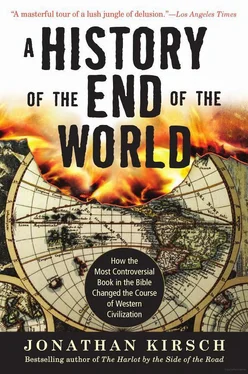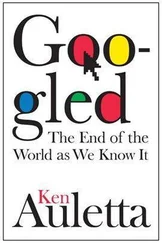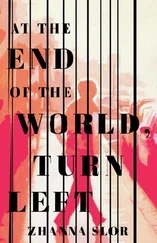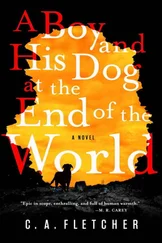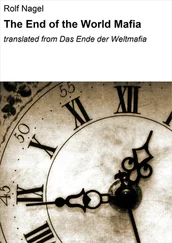Some of the most charismatic pulpit preachers discovered the power of television and thereby turned themselves into authentic superstars in Christian circles. Oral Roberts (b. 1918) and Billy Graham (b. 1918) can be credited with the invention of televangelism; both started their ministries as tent revivalists but moved on to radio in the 1940s and television in the 1950s. A whole generation of fundamentalist preachers followed their example, the most famous (or notorious) of which include Pat Robertson (b. 1930), Rex Humbard (b. 1919), Timothy LaHaye (b. 1926), Jimmy Swaggart (b. 1935), Jim Bakker (b. 1939), and Jerry Falwell (b. 1933), the latter of whom came to be described as “the prince of the electronic church.” 18
All of them couched their preaching (and their fund-raising appeals) in distinctly apocalyptic terms, playing on the fears and hopes of their electronic flocks in precisely the same way that the author of Revelation addressed his first readers and hearers. Ironically, both the daily newspapers and the Saturday-afternoon science-fiction flicks seemed to reinforce even the most urgent prophecies about the end of the world. “We may have another year, maybe two years to work for Jesus Christ,” warned Billy Graham during his 1950 crusade, “and [then] ladies and gentlemen, I believe it is all going to be over.” 19
The apocalyptic idea in Christian fundamentalism has always remained on the far side of a certain cultural divide in America. Like the author of Revelation, who detested the classical civilization in which he lived and preached, the latter-day readers of Revelation condemned some of the most celebrated features of American civilization. They feared big business, big government, and big labor; they were revolted by the entertainment that was available in the local movie houses, over the radio, or on television; and they adopted the “language arsenal” of Revelation to denounce the sinful and satanic world in which they found themselves.
A few American doomsayers, of course, have always accentuated the positive when it comes to the end of the world. The millennial kingdom, for example, is sometimes advertised as a celestial version of the American dream: “Everyone will be self-employed and will enjoy the full fruitage of his own labor,” declared one preacher. “Every single inhabitant of the world in that age will be independent, own his own property and his own home, and provide for his own family in abundance.” Another preacher optimistically calculated that “the ratio between the eternally lost and saved would be 1 in 17,476.” And an evangelist associated with the Moody Bible Institute conceded that “the Lord is going to judge America some day,” but he insisted that “we are justified in hoping our country will be spared and that Americans will share the joy of the kingdom.” 20
But the embers of resentment and revenge that burn at the core of Revelation always seem to explode into flames. “The United States has departed a-whoring after strange gods,” declared pioneering radio preacher Donald Grey Barnhouse shortly after the end of World War II. “The greed of the labor unions, the lust of Hollywood, the debauchery of the masses cry to high Heaven for judgment.” 21One preacher, sermonizing in 1949, blamed the public schools—“Godless, Bibleless, Christless”—for “clearing the path for Antichrist.” 22And M. R. DeHaan, the author of a 1963 apocalyptic novel titled The Days of Noah, attributed the moral decay of America to “women leaving their homes and children to enter factories and shops and offices” and described “people going almost completely crazy under [the] spell” of popular music: “Squeaks and squawks and empty groans and baby talking and monkey moans.” 23
Stripped of its sugarcoating, the apocalyptic vision of America is a weapon in the culture war between fundamentalism and the modern world: “God is going to judge America for its violence, its crimes, its backslidings, its murdering of millions of babies, its flaunting of homosexuality and sadomasochism, its corruption, its drunkenness and drug abuse, its lukewarmness toward Christ, its rampant divorce and adultery, its lewd pornography, its child molestation, its cheatings, its robbings, its dirty movies, and its occult practices,” declared evangelist David Wilkerson in 1985. “America today is one great holocaust party, with millions drunk, high, shaking their fist at God, daring him to send the bombs.” 24
All of the perceived ills of contemporary America were stitched together by some apocalyptic preachers into one vast web of conspiracy, with Satan planted invisibly but unmistakably at the center. At one time or another, the elements of the “cosmic conspiracy to install the Antichrist” have been said to include bankers, biofeedback, credit cards, computers, the Council on Foreign Relations, feminism, Freudian psychology, the human-potential movement, Indian gurus, “international Jews,” lesbianism, the Masons, Montessori schools, secular humanism, the Trilateral Commission, Universal Product Codes, and the United Nations—and the list is certainly not comprehensive. 25Even The Protocols of the Elders of Zion, long ago proven to be a work of crude anti-Semitic propaganda concocted by the secret police of imperial Russia, still surfaces now and then in apocalyptic circles.
Indeed, the conspiracy theory begins in the text of Revelation, where the author alerts his readers and hearers to the dangers of “the deep things of Satan” and warns them against the invisible working of Satan’s will through the creatures who are his agents and deputies. 26And so each new and unfamiliar phenomenon in postwar America could be seen by apocalyptic true believers as yet another manifestation of the same satanic conspiracy. Thus, for example, the technological revolution that brought computers into every aspect of American life inspired some readers of Revelation to regard credit-card numbers and pricing bar codes as “the mark of the beast.” After all, as the author of Revelation writes, “no one can buy or sell unless he has the mark, that is, the name of the beast or the number of its name” 27A few visionaries even insisted that “Antichrist would be a computer.” 28
But, paradoxically, the conspiracy theories were actually a source of comfort—“an anchor…in a world of uncertainty and doubt” for men and women who were confused and disturbed by the cultural and political upheavals of postwar America. 29Where a secular observer sees a “subtext of conspiracy, paranoia, and social alienation” in apocalyptic preaching, the true believer sees a revelation that invests history with “drama and meaning,” according to Paul Boyer. Indeed, otherwise comfortable and complacent Americans whose only afflictions are boredom and ennui are attracted to the chills and thrills of Revelation, and they find meaning in an otherwise meaningless world by embracing the old apocalyptic idea that “history is following a clear trajectory determined by God and that it is headed toward an ultimate, glorious consummation.” 30
Still, the antics and alarms of Christian doomsayers in postwar America were all but invisible to the audiences that laughed out loud at Dr. Strangelove when it was released in 1964. Of course, even a worldly or wholly secular family might be called upon by a pair of Jehovah’s Witnesses going door-to-door with a supply of free literature. Revelation: Its Grand Climax at Hand!, one publication of the Watchtower Bible and Tract Society, features comic-book illustrations of the whole unlikely bestiary of Revelation. And anyone who switched through the channels on the television dial on any Sunday morning in the 1950s or the 1960s would encounter the preachments of Oral Roberts or Billy Graham or countless other fledgling televangelists. But, by and large, the old ideas about the end of the world were confined to a kind of Christian ghetto while the rest of America accustomed itself to the idea that doomsday will be strictly a human enterprise.
Читать дальше
